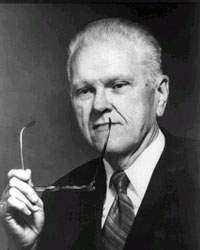 “During the ’30s, the microwave research conducted at Round Hill in South Dartmouth, Massachusetts, had participants from both Physics and Electrical Engineering. That work, together with the research on microwave components at MIT was probably instrumental in bringing the Radiation Laboratory to MIT.
“During the ’30s, the microwave research conducted at Round Hill in South Dartmouth, Massachusetts, had participants from both Physics and Electrical Engineering. That work, together with the research on microwave components at MIT was probably instrumental in bringing the Radiation Laboratory to MIT.
“In the fall of 1940, I was assigned to a short-wave antenna project which involved basic research on microwave components. The goal was to demonstrate the feasibility of automatically tracking a target using the reflected signal of a microwave beam that illuminated the target (the word radar had not yet been coined). By spring 1941, the group of research assistants under Professor William L. Barrow had conducted successful demonstrations, and many new RadLab recruits visited our one-room laboratory in Building 6 to see microwave equipment for the first time. Professor Barrow had become a consultant to the RadLab, and the military implications of an automatic tracking system imposed security restrictions on our work, so the antenna project was discontinued.
“One Saturday morning in June 1941, Professor Barrow came by the laboratory to see the basic component research still going on. He asked me to get my colleague W. H. “Bill” Radford, and we walked out to the center of the Great Court-presumably away from prying ears. He informed us that on the following Monday, a group of about 60 Army and Navy officers would arrive to begin a classified training program on electronics, microwave, and radio location equipment (radar). Professor Barrow said that Bill and I had been assigned to the program, and would give introductory lectures on electronic circuits. After a few weeks of introductory lectures, several RadLab staff members gave lectures on microwave radar equipment under development there. This was the first of three classes (each three months long) trained at MIT on the fundamentals of electronics and radar. After the first three classes, the operation expanded and was moved to the Harbor Building (now the Sheraton Building) on Atlantic Avenue in Boston. It was then designated as the MIT Radar School.
“I had a RadLab badge so I had access to the laboratory and the weekly seminars in order to carry out the mission of the MIT Radar School, but I was never a staff member of RadLab. Contact with the RadLab was essential to keep abreast of new developments, since we were planning curricula and teaching about equipment as it was scheduled to go into field use. A new class of approximately 150 officers arrived each month for a three-month training program. In its five years, the school trained more than 8,800 officers, enlisted men, and civilians in the theory and operation of the microwave radar being developed at the MIT Radiation Laboratory, and in the maintenance of radar equipment.
“Activities at the Radar School were winding down in 1946, and in January 1947 I became Assistant Professor of Electrical Engineering and a staff member in RLE. By that time, MIT had undertaken a program called Project Meteor sponsored by the U. S. Navy Bureau of Ordnance. Project Meteor was classified, and its research was to lead to the development of an air-to-air guided missile. Professor Lan Jen Chu, a student of Professor William L. Barrow and a former RadLab staff member, proposed a unique guidance system based on interferometry, and I worked with him in providing faculty supervision for this group. Several MIT departments and laboratories were involved in Project Meteor. The Aeronautics Department did research on air frames, the Combustion Lab studied propulsion systems, the Dynamic Analysis and Control Lab worked on control systems, and RLE investigated radar guidance. Project Meteor continued for six or seven years, and the interferometric guidance system was successfully tested. When Project Meteor ended, the guidance work in RLE led naturally to basic research on phased-array radar.
“In recent years, there has been considerable criticism of the government-industry-academic relationship. In my opinion, the cooperation between military, industrial, and academic institutions has not interfered with the others’ separate missions and goals. This cooperation was extremely important during World War II, and has continued to strengthen all three parties in the alliance.”
- Professor Henry J. Zimmermann in RLE Currents, Spring 1991
